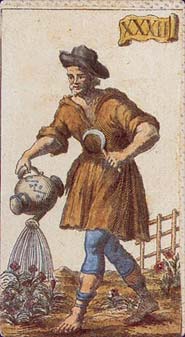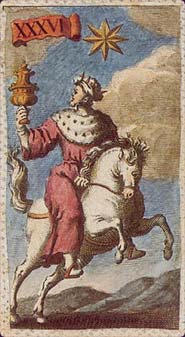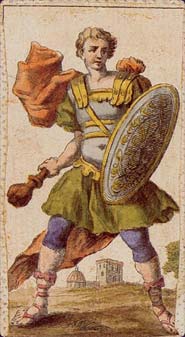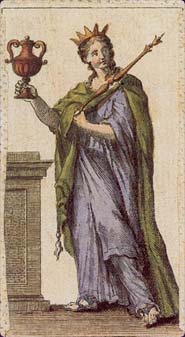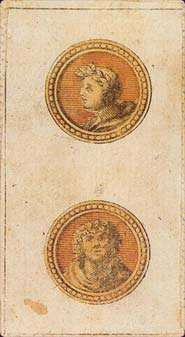Minchiate Tarot Deck Review
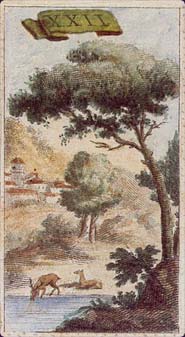
Creators: Unknown
Published: 2011
The Minchiate Tarot is a reprint of the historical Ancient Minchiate Etruria Tarot. The deck is a photo reproduction of a Florentine Minchiate deck from 1725, which has 56 minors and 41 major arcana, with cards for the signs, planets and virtues.
Retailers
See Price at Amazon.comSee Price at Amazon.ca
Minchiate Tarot Review by Lillie
The Minchiate Tarot by Lo Scarabeo is a photo reproduction of a Florentine Minchiate deck from 1725. A reprinting of the deck they originally published in the 1990s, long out of print and much desired by collectors of historical decks and those interested in the development of the tarot. It includes 97 cards, the usual 56 that comprise the minor arcana of the tarot, and an extended major arcana whose 41 cards follow the tradition of Minchiate decks.
The cards are housed in a sturdy box with a neat magnetic closure and are accompanied by a fully illustrated book that gives information and instructions in five European languages. At the back of the book all 97 cards are illustrated in full colour for ease of reference. The cards are housed in a double well beneath the book where a simple white ribbon allows for easy removal.
Smaller than the typical Lo Scarabeo deck the cards measure 57x102 mm (2.2x4 inches), and fit easily into the hand despite the thickness of the extended deck. The backs of the cards feature a woodcut print of a woman against a pale brown background with the legend 'ETRURIA' beneath her. This design is bordered by a spotted design on the same brown background. This border is repeated on the front of the cards and surrounds the images, imitating the wrap around edges of the original. Both the backs and the faces of the cards reproduce the original deck from 1725 including the delicate, muted colours of the period. All cards are unnamed, although the majors carry Roman numerals from I to CL. The fool is unnumbered. The Minor arcana is also unnumbered and unnamed, relying upon the images to denote the number and suit of the card.
The 41 majors include cards that can be compared to most, if not all, of the typical tarot majors, although the Papess is missing, and the Empress, Emperor and Pope have been transformed into the politically neutral figures: the Grand Duke and the Emperors of the West and East. The numbering of the cards is not analogous to the numbering of the conventional tarot due to the presence of the extra cards inserted into the body of the deck. These additional cards are typical of the Minchiate tradition. These include ideas and concepts familiar to the time in which they were created, such as the astrological sighs, the Christian virtues and the four elements, which between them encompass the entirety of the world and the heavens.
The major arcana depicts these concepts using a system of meaningful images. These symbolic pictures, developed centuries before, would have been familiar to those that first used these cards, but seem opaque and strange to the modern viewer, such as Prudence with her mirror and her snake, and Charity holding the flame in her hand. Other symbols, such as the scales and sword of justice have persisted through the centuries and remain familiar to the modern mind, giving tantalising hints of the fullness of experience accessible to those that first used these cards.
Even in the cards associated with the normal tarot deck it is possible to discern something older, a harking back to the past rather than looking toward the future. In this deck the card generally associated with the Hermit shows an ancient man, his bony limbs supported by crutches, behind him an hourglass, its sands almost gone. This is not a depiction of the hermit, bearing the light of wisdom on his search for truth, but the older image found in decks from the 15th century, that of time and age. Khronos of the Greeks, Old Father Time, and the age that comes to us all as the hourglass of our life runs dry.
The Minor arcana is more conventionally structured. Four suits showing wands, swords, cups and coins: ten pip cards and four court cards in each. The pip cards show arrangements of their suit signifier, five interlinked wands on the 5 of Wands, two elaborate cups against a cream background on the 2 of cups. However, some pip cards are accompanied by small vignettes. The 3 of Swords shows a she-wolf suckling two small children, a classical reference to the founding of Rome, and the scene on the 2 of Wands is a clear allusion to a fable by Aesop, the fox and the stork. Other scenes are more obscure, the 4 of Cups shows an ape studying it's own reflection in a mirror, perhaps a reference to misplaced vanity, and the fox in the hen house on the 5 of Swords may be no more than a generic depiction of danger.
The suit of coins shows the requisite number of coins on each card and, with the exception of the Ace and the 9, all show heads upon the faces of the coins, each head original and distinct, showing different people, postures or expressions. The large, elaborate coin on the Ace shows two people building a wall, but the 9 inexplicably shows birds upon the coins, again each different and distinct.
The court cards differ from normal tarot iconography in two ways. As with most traditional decks they show Page, Knight, Queen and King, all holding the suit emblem. However while the King and Queen are enthroned as usual the Knights show not mounted men, but chimera, mythical creatures half man and half beast. The Pages stand, but whilst those of Wands and Swords show young men the suits of Cups and Coins both show young women, giving more balance in the depiction of the genders than is normal in an historic deck.
Although the book that accompanies this deck is divided into five different languages it still manages to include a fair amount of information. Beginning with an overview of the Minchiate tradition in tarot history, it goes on to give meanings for all 97 cards, paying particular attention to the majors, the majority of which will be unfamiliar to those more used to the usual 78 card deck. Following this is a detailed spread particularly designed to make the best use of a minchiate deck. In this method the cards are divided into their respective classes. This makes best use of the structure of a Minchiate deck and also serves as a teaching tool, familiarising the reader with the new cards that they must become conversant with.
If a reader were not comfortable with the extra cards this deck could easily be adapted for use as a normal 78 card tarot deck by the simple expediency of removing the extra cards and using one of the female virtues as a substitute for the missing Papess. The surprisingly feminine 'Grand Duke' makes an excellent empress and the Emperor of the East has no difficulty standing in for the Pope. Of course the sequence of the numbers will be wrong, but the iconography of the images is clear enough for anyone familiar with the tarot to use these cards with ease.
Although a reproduction, this deck has the feel of something very old. Looking through the cards is akin to peering into the quintessential mystery of the tarot. With their muted colours and rich symbolism the cards seem to whisper ancient secrets in a half forgotten language, revealing hints of a code that was once known to all but which can be rediscovered through the potent images of this deck.
The republication of this deck is important for the preservation of tarot history, enabling both historians and collectors to hold a piece of history in their hands. It will also be of value to the general reader, both those that would wish to experiment with pip cards, or those that may want to stretch their reading ability through the novel structure of the Minchiate tradition.
Complete Details of Minchiate Tarot
Creators: UnknownPublisher: Lo Scarabeo 2011
Deck Type: Tarot Deck
Cards: 97
Major Arcana: 41
Minor Arcana: 56
Deck Tradition: Minchiate
Card Size: 2.24 x 4.02 in. = 5.70cm x 10.20cm
Card Language: None
Back Design: Woodcut print of a woman against a pale brown background with the legend 'ETRURIA' beneath her, with a spotted brown border.
Rating: 14/20 or
Similar Decks to Minchiate Tarot
Theme: Historical ReproductionCreator: Angel Tarot, Angel Tarot, Art Deco Fortune Telling Cards, Astro Mythological, Astro Tarot, Auramour Tarot Divinatoire, Braille Spanish Tarot, Clow Cards, Dragon Age Inquisition Tarot, Eternal Tarot, Flying Hearts Tarot, French Cartomancy, Gypsy Witch Fortune Telling Playing Cards, La Vera Sibilla, Le Tarot d' Oswald Wirth, Le Tarot de Marseille (Accademia dei Tarocchi), Magic Slavonic Tarot, Mlle Lenormand Blue Owl, Mlle. Lenormand Cartomancy, Mystic Pug Tarot, National Geographic Tarot, Oracle Dessuart, Power Animal Tarot, Prager Tarot, Royal Tarot, Taro Adivinhatorio, Tarocchi Napoletani, Tarocco Piemontese, Tarot Card Alice, Tarot Card Misty, Tarot de Marseille (Fournier), Tarot de Marseille (Piatnik), Tarot de Marseille Mamanmiyuki, Tarot Genovese, Tarot of Marseille Mini, Tarot of Marseilles (Grimaud), Tarot of Marseilles (US Games), Tarot of Transition, Tarot Piatnik Wien, Tarot Sola Busca, Visconti-Sforza Tarot, X War Tarot by -- Unknown
< Previous Deck · Back to Top · Next Deck >
Home > Tarot Reviews > Minchiate Tarot Review

